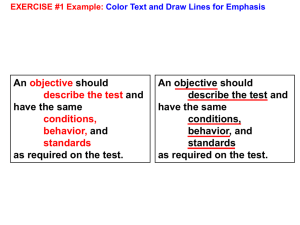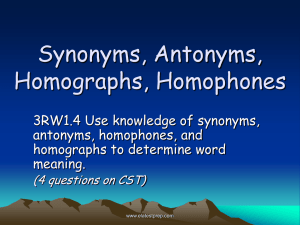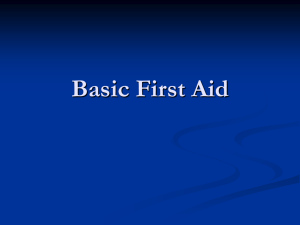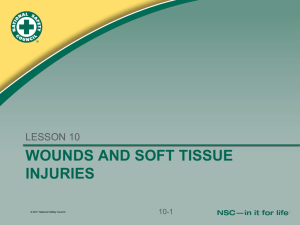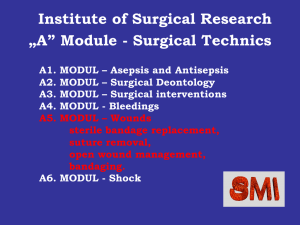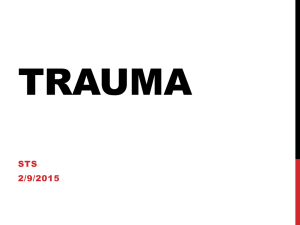Wound Bandaging- student 2
advertisement
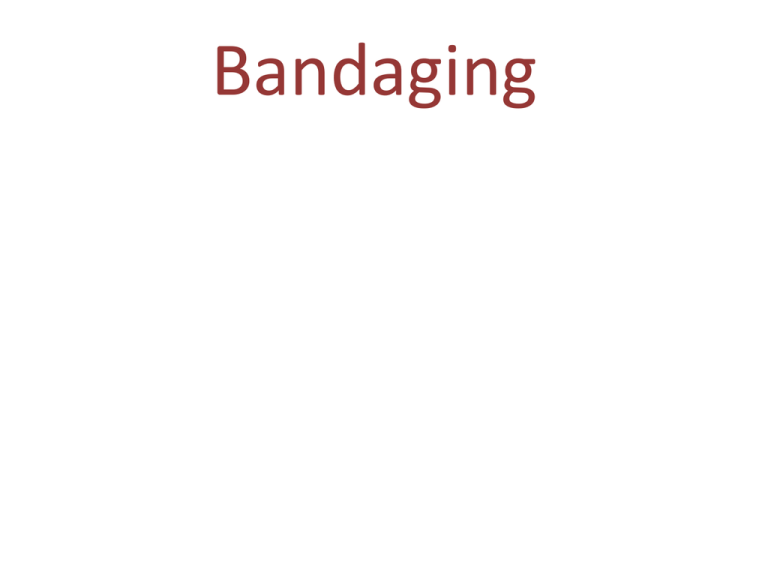
Bandaging Learning Objectives Discuss indications for bandaging of wounds and describe the general structure of bandages Describe common types of bandages, slings, splints, and casts used for small and large animals and provide indications for their use Learning Objectives Describe procedures for monitoring of animals with casts, bandages, splints, or slings Discuss considerations for bandaging of abrasions, lacerations, puncture wounds, and degloving injuries Describe classifications of burns and discuss management of burn patients Bandaging Purpose – To prevent simple fractures from becoming more complicated – Protection from licking, scratching, biting and any other forms of self mutilation – From infection or further contamination – Holding wound dressings and cold compresses in place – Immobilizes the wound and promotes healing Bandaging Purpose – To improve mobility – To reduce pain and swelling – Extra support for internal fixation of fractures Bandaging Purpose - Compression bandages are a useful first aid measure to help arrest hemorrhage. - Post operatively, bandaging is useful to prevent excess swelling; therefore reducing and preventing edema Bandaging Purpose – Of a fractured limb to prevent further trauma to damaged soft tissue – Of limb to aid speedy recovery of open wounds if near a joint, where excessive movement is undesirable – Of limb, if fracture repair is complicated and/or near the joint requiring complete rest – If internal fracture repair is not sufficient, and extra support in the form of a bandage is needed – Following manipulative procedures, after dislocated hips having been reduced Bandaging Purpose – To hold IV catheter in place – To keep limb extended for fluid lines and other such procedures – When necessary, to secure tail bandage to base of tail – To tape pinnae together above dogs head, for ear or head bandage Bandages – Wound Healing 1.Protecting the wound from additional trauma and contamination 2.Preventing wound dessication (drying up) 3.Preventing hematoma and seroma formation 4.Immobilizing the wound to prevent cellular and capillary disruption Bandages – Wound Healing 5. Minimize post-op edema around incision 6. Absorbs wound exudate and lifts away foreign material & loose tissue as bandage is removed 7. Promotes an acid environment 8. Keeping wound warm Important Points to Remember • The bandage must serve the purpose for which it was intended • The bandage must be applied firmly, but not so tightly that circulation is impaired • It must be as comfortable as possible for the patient. • It must look professional – take pride in its appearance Bandage Layers Primary (contact layer) Is the first layer and it is in direct contact with the skin or wound Telfa Pads Gauze Sponges Open wounds should have a sterile primary layer Primary Layer: Functions Debridement Deliver medication Transmit exudate to 2nd layer Seal wound Primary Layer – Adherent • An adherent primary layer promotes debridement in the inflammatory stage – Uses a wide mesh material (sterile gauze), allowing tissue to become incorporated into the bandage. This tissue is then removed with the bandage change – Not highly recommended due to unselective debridement and damage during the proliferative (repair) stage of wound healing – Painful to remove – Must be changed daily – Bacterial proliferation and strike-through = disadvantages with wet/dry primary layer Types of Adherent Primary Layers • Dry-to-dry – Used when loose, necrotic tissue is evident. – Absorbs exudate, necrotic tissue, and foreign material. – Debris adheres to dry, sterile gauze and is removed with bandage change • Wet-to-dry – – – – Used for wounds with dried or semi-dry exudates Gauze is soaked in saline or chlorhexadine and applied wet Loosens material from the wound by rehydration As it dries, exudate is pulled into the material and away from the wound Adherent Primary Layers (cont’d) • Wet-to-wet – Used on wounds with large amounts of exudates and transudates – Material covering the wound is kept moist, sometimes by injection of fluid into the bandage – Absorbs fluid easily – Can be used to heat wound, increasing capillary action and drainage of wound – Removed wet (less pain) – Disadvantage: little wound debridement because of decreased adhesion to necrotic tissue Primary - Nonadherent • Moist wound care is the most important management principle • A nonadherent bandage is usually a fine mesh, nonstick material. This layer promotes moisture retention and epithelialization with minimal disruption of granulation bed. – Moist wound care enhances natural debridement within the wound by drawing the exudate form the wound and allowing the wound to bathe in this cytokine-rich material – Involves the uses of nonadherent primary bandage layers that act to keep the wound surface moist – Moist wound care results in less inflammation and less wound disruption • Either occlusive or semiocclusive Primary - Nonadherent – Allows air and moisture to move through the dressing – Keeps wound moist yet draws exudate and debris form the wound – Indicated for moderate to copious exudate – Must be changed frequently (Every 1 – 3 days, depending on exudate production) Primary – Nonadherent Semiocclusive • Hydrogel • Hydrocolloid • Hydrophilic • Polyurethane film • Hydrophilic colloids (Refer to p. 1237 of CTVT text) Primary - Nonadherent • Impermeable to moisture • Allows some air transfer • Indicated for minimal exudate • Promotes epithelialization • Changed infrequently (every 4-7 days) • Can be used as a protective layer for new epithelium preventing desiccation and abrasion of the fragile tissue. • Some products adhere to skin (hydrophilic or nonhydrophilic) Bandage Layers Secondary Covers the primary layer and supports the wound Purpose is to be able to absorb and store fluids from the wound Materials that can be used for this layer are cast padding or cotton roll. This layer should not be applied with excessive pressure but snug enough to keep the primary layer in Bandage Layers Tertiary layer This is the holding and protective layer that holds the bandage in place Usually consists of two layers Vet Wrap Elastakon Cling gauze Tertiary Layer • Should be nonocclusive to allow air transfer • Strike-through = outer layer becomes wet, allowing moisture (and bacteria) to wick through the rest of the bandage MUST CHANGE IMMEDIATELY! • Occlusive = contraindicated (traps excessive moisture leading to tissue maceration) Technician Note • The middle two toes of a bandaged limb should always be exposed to allow for assessment of color, warmth, and swelling


